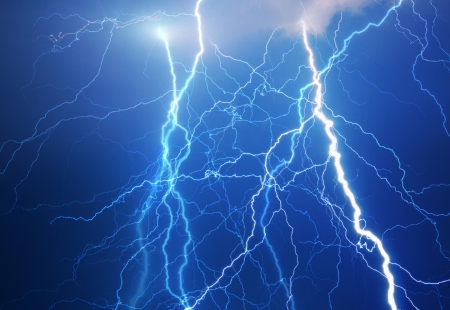
What You Should Know About Lightning Safety

What are some tips for lightning safety?
Lightning can travel from outside your home to inside your home -and to you - through materials that conduct electricity, including electrical wiring, phone lines, water, and plumbing. These safety guidelines will help minimize your risk.
When you first hear thunder, it’s time to take precautions indoors.
If you’re inside and you hear thunder or see lightning, it’s time to take precautions. Continue your indoor safety precautions for 30 minutes after you see the last lightning or hear the last thunder.
Never touch wiring during a thunderstorm.
It's too late to unplug your electronics if thunderstorms are close. If you count 30 seconds or less from when you see lightning to when you hear thunder, you missed your chance to unplug your home electronics. If you’re in the lightning danger zone, you should not touch any wiring, even just to unplug your home electronics!
Avoid using phones and only use cell phones or cordless phones.
If you need to use the phone, corded phones are dangerous during thunderstorms. Lightning traveling through the telephone wires has killed people. Cell phones and cordless phones are a safer choice, but stand away from the cell or cordless phone’s power base. Be sure to keep your cordless and cell phones charged; they may not work if your power goes out.
Wait to use any plumbing.
Sinks, showers, tubs, and toilets can conduct electricity from lightning strikes from outside your home to you.
Stop playing video games connected to your TV.
Electronic equipment with handsets, joysticks, and headsets connected by wiring to your TV, computer, or stereo are dangerous during thunderstorms. Stop playing-and stop your children from playing video games connected to TV during thunderstorms. The wiring creates a path for lightning to reach you from outside your home.
Stay away from windows.
Metal window frames can conduct electricity. Windowpanes can break from the acoustic shock of thunder, wind-blown objects, or large-size hail.
Keep flashlights, battery-operated lights, and radios ready to use.
If your power goes out, use flashlights or battery-operated lights instead of candles. Candles are a fire hazard. Have a battery-powered radio available for updated weather conditions.
Outdoor Safety
No place outside is 100% safe from lightning during a thunderstorm. However, there are some precautions you can take to minimize your risk.
There is no reason to be caught off guard by a thunderstorm.
The best way to avoid lightning is not to put yourself, family, and friends in danger in the first place. No one should be caught “off guard” by thunderstorms.
Outdoor sports and thunderstorms are a deadly combination.
Lightning in open fields kills more people than any other outdoor place. Outdoor sports activities on large open fields - like soccer, golf, baseball, and softball - usually peak during thunderstorm season in most states. Players, coaches, and staff often push their luck when thunderstorms threaten their safety, hoping to get one more hole in, one more kick-off, or one more batter up. The consequences can be deadly.
Know the lightning safety-warning program at your outdoor sports facility.
Outdoor recreation facilities, such as golf courses, should have a formal lightning warning policy that meets these two basic requirements:
- Lightning danger warnings can be issued in time for everyone to get to a safe shelter.
- There is access to adequate safe shelter - such as a clubhouse or locker room.
For more information on lightning safety recommendations for outdoor sports facilities, email us.
Watch for thunderstorms and use the 30/30 rule.
During thunderstorms, no place outside is safe. But lightning safety experts agree that you can minimize your risk if thunderstorms develop or approach by following these steps:
- Designate someone from your group to be the storm watcher.
- Use the 30/30 rule:
- When you see lightning, count the seconds until you hear thunder.
- If this time is 30 seconds or less, quickly go inside a substantial building. If such a building is not available, a metal-topped vehicle is the next best choice.
- Wait at least 30 minutes after seeing the last lightning or hearing the last thunder before going back outside.
Get off the water, out of open spaces, and away from trees.
Avoid the two most deadly places, open spaces and under trees during thunderstorms. Also, avoid things that conduct electricity, such as water, utility lines, and metal fences. Get to a safe place as quickly as possible. A substantial enclosed building is the safest place. A metal-topped vehicle with the windows up is the next best alternative if you can’t get to a building.
- Boaters: Get off the water and go to a safe place.
- Swimmers: Get out of the water and go to a safe place.
- Players on open playing fields: Get off the field and go to a safe place.
- Golfers: Leave the golf course and go to a safe place, such as a clubhouse.
- Hikers: Turn around and go back to a building or your metal-topped vehicle.
Your last resort is to stay low and stay away from trees and other tall things.
If you’re still outdoors and lightning has struck close to you, crouch down into a ball on the balls of your feet. Your goal is to be the smallest target possible with the least contact with the ground. Do not seek shelter under tall or isolated trees or unsubstantial shelters. It’s better to be wet from the rain than dead or disabled from lightning.
If someone is struck by lightning, call 9-1-1 or the emergency service agency in your area. If the victim’s heart stopped or they stopped breathing, immediately administer CPR.
For more information The National Institute of Standards and Technology (nist.gov) lightning safety website features many helpful articles.